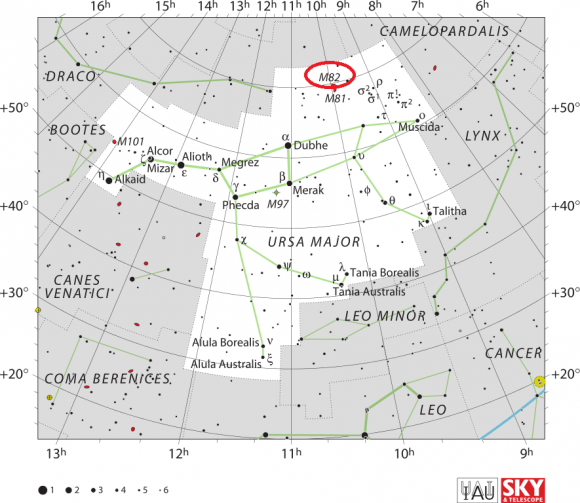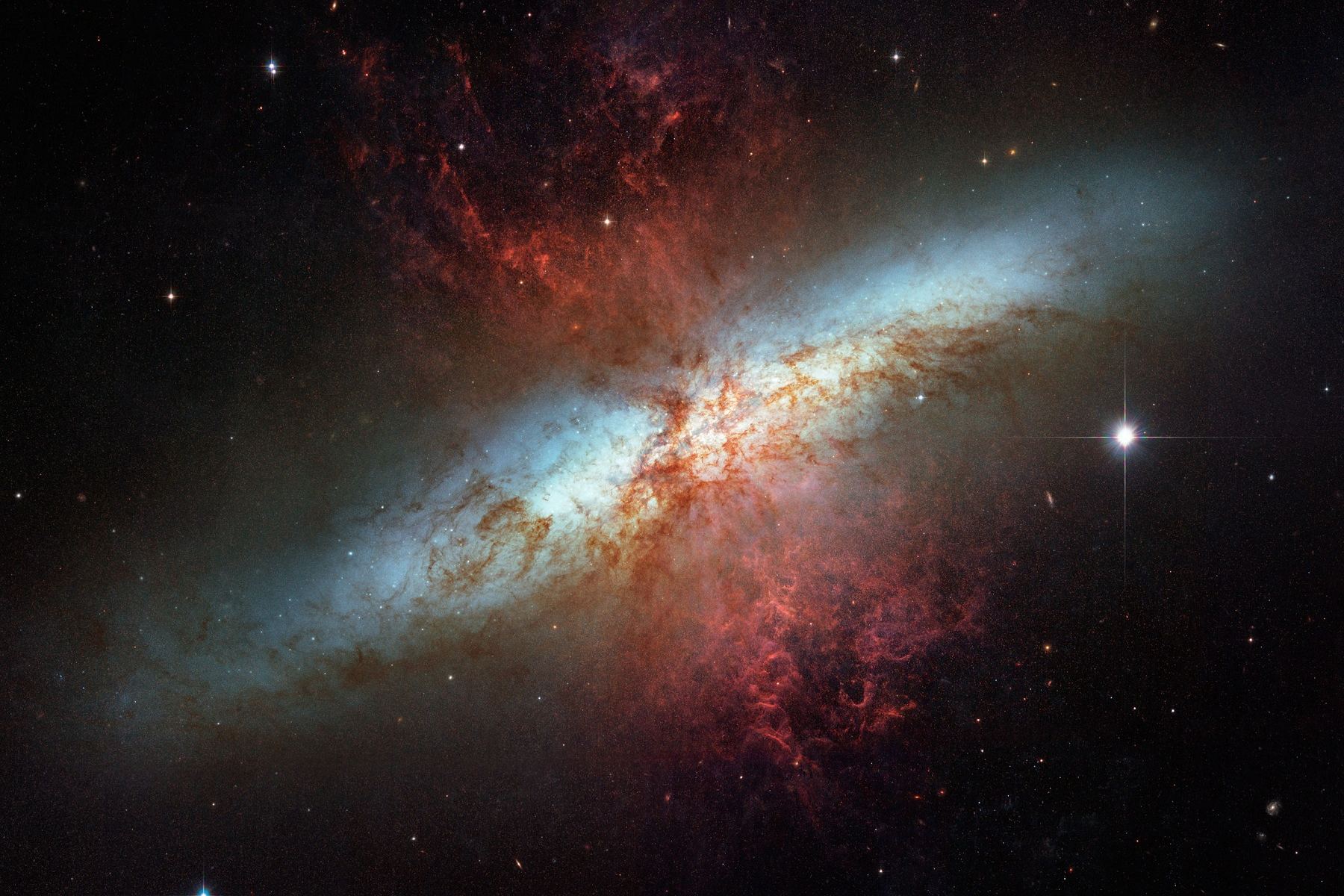Welcome back to Messier Monday! Today, we continue in our tribute to our dear friend, Tammy Plotner, by looking at the Cigar Galaxy – also known as Messier 82!
During the 18th century, famed French astronomer Charles Messier noticed the presence of several “nebulous objects” while surveying the night sky. Originally mistaking these objects for comets, he began to catalog them so that others would not make the same mistake. Today, the resulting list (known as the Messier Catalog) includes over 100 objects and is one of the most influential catalogs of Deep Space Objects.
One of these objects is the starbust galaxy known as Messier 82, which is also called the “Cigar Galaxy” because of its distinctive shape. Located about 12 million light-years away in the constellation Ursa Major, this galaxy’s starburst action is thought to have been triggered by interactions with the neighboring galaxy M81 (aka. Bode’s Galaxy).
Description:
One of the most fascinating parts about this irregular galaxy is its easy to see distorted disk… it looks much like a child’s dirty kite string wound around a stick. Famous for its heavy star-forming activity, M82 is a prototype member of the class of starbursting galaxies called Seyferts. Its core was absolutely shattered by its encounter with M81 and it literally crackles with radio activity.
It’s explosive gas flow is also a strong source of radio noise, discovered by Henbury Brown in 1953. The radio source was first called Ursa Major A (strongest radio source in UMa) and cataloged as 3C 231 in the Third Cambridge Catalogue of Radio Sources. As E. R. Seaquist (et al) explained in a 2006 study:
“The compact nonthermal sources in M82 and other starburst galaxies are generally thought to be supernova remnants (SNRs). We consider an alternative hypothesis that most are wind-driven bubbles (WDBs) associated with very young super star clusters (SSCs). In this scenario, the synchrotron-emitting particles are produced at the site of the shock transition between the cluster wind and the hot bubble gas. The particles radiate in the strong magnetic field produced in the expanding shell of shocked ambient interstellar gas. One of the motivations for this hypothesis is the lack of observed time variability in most of the sources, implying ages greater than expected for SNRs, but comfortably within the range for WDBs. In addition, as SNRs these sources are not effective in driving the starburst mass outflow associated with the nuclear region of M82, thus requiring a separate mechanism for coupling supernova (SN) energy to this outflow.”
In the infrared light, M82 is the brightest galaxy so far know. It exhibits an infrared excess – much brighter at infrared wavelengths than in the visible part of the spectrum. As N. M. Förster Schreiber (et al) said in a 2001 study:
“Our results provide a set of constraints for detailed starburst modeling, which we present in a companion paper. We find that purely foreground extinction cannot reproduce the global relative intensities of H recombination lines from optical to radio wavelengths. The excitation of the ionized gas indicates an average effective temperature for the OB stars of 37,400 K, with little spatial variation across the starburst regions. We find that a random distribution of closely packed gas clouds and ionizing clusters and an ionization parameter of 10-2.3 represent well the star-forming regions on spatial scales ranging from a few tens to a few hundreds of parsecs. From detailed population synthesis and the mass-to-K-light ratio, we conclude that the near-infrared continuum emission across the starburst regions is dominated by red supergiants with average effective temperatures ranging from 3600 to 4500 K and roughly solar metallicity. Our data rule out significant contributions from older, metal-rich giants in the central few tens of parsecs of M82.”
Recently, over 100 new, young globular clusters have been discovered with the Hubble Space Telescope. This neolyth formation is caused by m82’s 100 million year old encounter with M81. According to S.J. Lipscy’s 2003 study:
“Seven star-forming clusters are identified, which together provide ~15% of the total mid-IR luminosity of the galaxy. We find that these young stellar clusters have inferred masses and sizes comparable to globular clusters. At least 20% of the star formation in M82 is found to occur in super star clusters.”
History of Observation:
M82 is the was discovered on the same night as M81 by Johann Elert Bode, who found the pair on December 31, 1774. According to his historical notes:
“I found through the seven-foot telescope, closely above the head of UMa, east near the star d at its ear, two small nebulous patches separated by about 0.75 degrees, the positions of which relative to the neighbored small stars are shown in the tenth figure. The patch Alpha (M81) appears mostly round and has a dense nucleus in the middle. The other, Beta, on the other hand, is very pale and of elongated shape. I could determine the separation of Alpha to d as 2deg 7′, to Rho as 5deg 2′ and to 2 Sigma as 4deg 32′ with some acuracy; Beta was too faint and disappeared from my eyes as soon as I shifted apart the halves of the objective glass.”
Pierre Mechain independently recovered both galaxies in August 1779 and reported them to Charles Messier, who added them to his catalog after taking data on February 9, 1781. Messier reports:
“Nebula without star, near the preceding [M81]; both are appearing in the same field of the telescope, this one is less distinct than the preceding; its light faint and [it is] elongated: at its extremity is a telescopic star. Seen at Berlin, by M. Bode, on December 31, 1774, and by M. Mechain in the month August 1779.”
However, it would be 1837 and Admiral Smyth before anyone really discovered some details:
“No. 81 is a fine bright oval nebula, of a white colour, in the Great Bear’s ear, which was first registered by M. Messier in 1781, and exhibited a mottled nebulosity to WH [William Herschel]. Its major axis lies np [north preceding, NW] to sf [south following, SE]; and it certainly is brightest in the middle. There are several minute companions [stars] in the field, of which a close double star in the sp [south preceding, SW] quadrant is No. 1386 in Struve’s grand Catalogue, and by him marked vicinae; the members are both of 9th magnitude, and trend np [north preceding, NW] to <7>sf [south following, SE], about 2″ apart, forming a fine though difficult object. With a low power, No. 82 M. can be brought into the north part pf the same field of view, although they are half a degree apart. It is very long, narrow, and bright, especially at its northern limb, but rather paler than No. 81. A line drawn through three stars in the sp [south preceding, SW] to a fourth in the nf [north following, NE] passes directly through the nebula. The two nebulae precede Lambda, in the end of Draco’s tail, by 25deg, but as the vicinity is deficient of large [bright] stars, they are not readily fished up. The apparent place here taken, is that of a small star between the two nebulae, which was differentiated with 29 Ursae Majoris, and every care taken in the reduction. The bright star in the animal’s chest, south of 29, viz. Phi, is pronounced to be double, both companions being of the 5th magnitude, and only half a second asunder.”
Locating Messier 82:
Bright M82 is fairly easy to find – once you catch on to a certain trick. By using the lower star closest to the “handle” in the bowl of the Big Dipper, draw a mental line between it and Alpha – the top outside star of the asterism. Now follow the same trajectory and extend that line approximately 1/3 further into space and you’ll have the approximate area!
Once you are there, both M82 and larger, brighter companion galaxy M81 are easy to spot in a finderscope or small binoculars. With minimal magnification, the pair of galaxies will appear like to small “cat’s eyes” glowing in the dark. Because of the relative brightness, both stand up well to urban lighting conditions and a great deal of Moon interference.
The galactic pair makes a wonderful study for small telescopes and binoculars! Don’t let M82’s “irregularity” escape you!

And here are the quick facts to help you get started with this Messier Object:
Object Name: Messier 82
Alternative Designations: M82, NGC 3034, Cigar Galaxy
Object Type: IR-II Irregular Galaxy
Constellation: Ursa Major
Right Ascension: 09 : 55.8 (h:m)
Declination: +69 : 41 (deg:m)
Distance: 12000 (kly)
Visual Brightness: 8.4 (mag)
Apparent Dimension: 9×4 (arc min)
We have written many interesting articles about Messier Objects and globular clusters here at Universe Today. Here’s Tammy Plotner’s Introduction to the Messier Objects, M1 – The Crab Nebula, Observing Spotlight – Whatever Happened to Messier 71?, and David Dickison’s articles on the 2013 and 2014 Messier Marathons.
Be sure to check out our complete Messier Catalog. And for more information, check out the SEDS Messier Database.
Sources:

